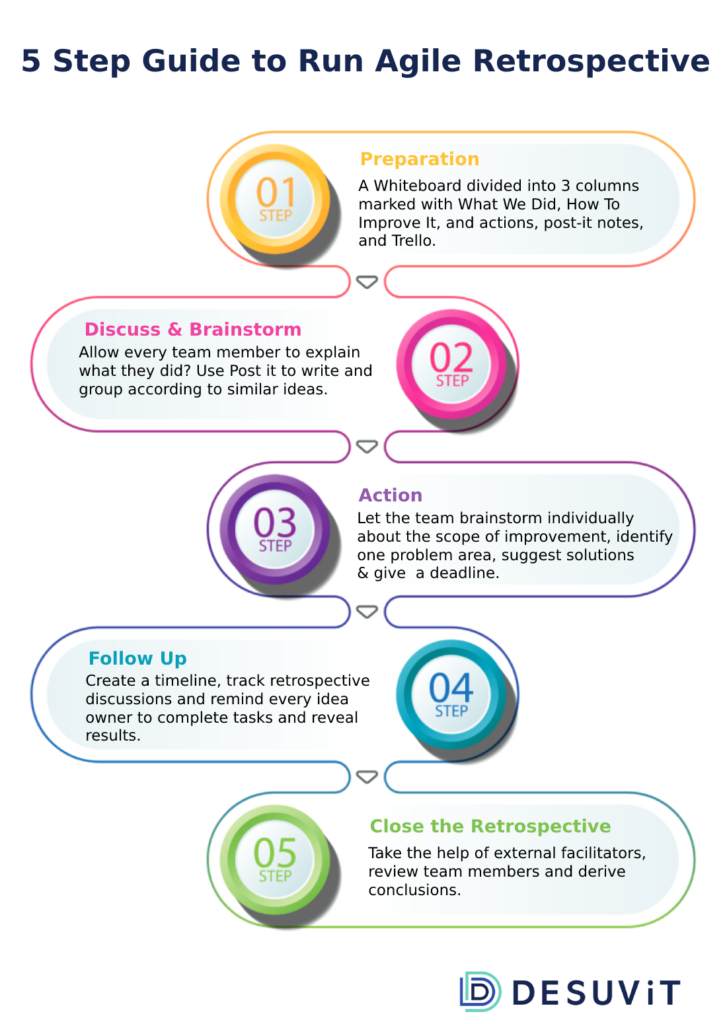Can you spot the time when your team was productive and when it was not? Can you spot when your team is on the way towards improving or declining? Can you spot if the process your team follows is optimal?
You cannot answer any of these questions if you do not measure. You cannot know how your team is doing if the team does not routinely observe together, aiming at improving themselves.
As Albert Einstein said, “The definition of insanity is doing the same thing over and over again but expecting different results.” If you want to improve, you need to find the right things to do as a team.
Agile retrospective helps to do that exactly – Find what works for the team, what does not work, and what the team should change to improve the overall output.
In an agile work setup, we are determined to team meetings, small rituals, such as daily meetings, sprint planning, reviews, and agile retrospective.
The reason agile retrospective is included in the routine is to understand improvements according to the events of the previous sprint. There’s no doubt in the fact that retrospectives are essential for better and improved functioning. But, you need to understand retrospectives for improved results. There’s no point in having a retrospective that doesn’t evaluate and question! With agile retrospective, you can analyze your processes and change what isn’t working and do more of what is.
Why is Agile Retrospective Important?
The motive of the agile retrospective is clear: to constantly improve as a team.
The reason we have highlighted this is that this is precisely why we use retrospectives. We can’t keep executing the same processes throughout the project lifecycle and expect varied results in the end. That’s not possible! The problem solving itself needs modifications to deliver value. If you wish to offer the most to the customer, you need to make changes, solve issues, and bring new processes.
Only then, the entire team becomes empowered.
The fundamental reason to use agile retrospective is to get through the hierarchy. Every team member receives an equal opportunity in retrospect. Every team member assesses the failures and celebrates the successes. Everyone participates, shares their views, and finds an amicable solution to the problem. In essence, a retrospective is a team exercise done collectively to look over the past and find areas to improve.
If you successfully incorporate agile retrospective culture in your development process, you would regularly take small steps of improvements. These small steps would create a culture of growth and productivity in the entire development team.
Understanding Agile Retrospective
The agile retrospective is a process of improving our software development cycle. It is a part of the agile framework that is placed at the end of every sprint.
In agile retrospective, the entire team sits down, evaluates the process of becoming better, and adapts according to it.
The scrum master conducts this retrospective through one of the various formats. However, in every format, the following factors are present:
- Discovery and identification of the entire sprint. The whole team understands the situation through discussions of the good and the bad. Here, a series of topics are covered, from personal relationships to technical practices utilized by the team during agile development. Once the discussion and discovery phase is over, the revelations are organized to focus on essential issues.
- After understanding the essential areas of improvement, possible solutions are considered. The entire team contributes to finding probable solutions to the challenges discussed.
- After the discovery and solution-seeking, the most essential and actionable improvements are sorted and put to action. It is best to do only 1-2 realistic changes that benefit the project.
From the above discussion, it may be already clear that agile retrospective requires consistent effort and time from the team. This helps in improving the performance of the team and building a team that is goal-oriented and empowered.
If you correctly conduct an agile retrospective, then similar to compound interest, your long-term benefits will outweigh the short-term difficulty.
Dual Motive of Agile Retrospective
If you look at it, then agile retrospectives have dual motives.
- First, we understand what is working and what is not working for the team.
- Then, we adopt the process for improvement.
Generally, every retrospective will first discuss the benefits and changes achieved with previous retrospective changes. After this, further improvements are implemented and communicated to the entire team.
How Much Time Should It Take?
Usually, the teams dedicate around 45 – 60 minutes to the retrospective every two weeks. If you are conducting retrospectives every month or twice a month, you may need around one to two hours. If the team has never done a retrospective earlier, you might want to spend more time understanding and finding the best ways to conduct the retrospective. Spend some more time in the first few retrospectives so everyone understands it better and can contribute.
How To Run Agile Retrospective?
If you are already willing to understand how you can run your first retrospective as the scrum master, then check out. Here’s a stepwise description of how agile retrospective works:
Preparation
Time Needed: 15 minutes (approx)
If you have both remote and office teams, then you need to do this first:
- The in-person teams need a whiteboard with various post-its and a marker in the meeting room.
- The remote teams need a digital collaboration document, which can be a Trello board or a pre-made collaboration template.
When you create these boards, make columns with What We Did, How To Improve It, and Actions.
Once you have this sorted, we can move to the next step. This will take approximately 15 minutes for the first time. Then, you can reciprocate the format for the following retrospectives.
Things To Remember
Time Needed: 5 minutes
- Retrospectives are not personal. So, this should be clear in the mind of every team member.
- Every member should keep an open mind during the retrospective. We can sit with a ‘There’s nothing wrong’ attitude.
- Don’t invalidate anyone with less experience. Everyone’s opinion is valid.
- Select the time for which this retrospective is being held. For instance, complete project, last sprint, etc.
- Don’t blame. Focus on success and improvement.
- If you have already had one or more retrospectives, quickly give an overview of the actions, themes, and results. This will create a sense of continuity.
What did We do?
Time Needed: 15 minutes
Whether you are on a digital board or a whiteboard, allow team members to explain their work. Use post-its to depict everything good on the board. Every post-it should contain only one good idea or implementation or success.
Once this is done, discuss every post-it note in detail.
How to Improve It?
Time Needed: 15-25 minutes
After this, allow every member to write a post-it about improvements. Everyone has some idea of a better process and implementation. Allow them to put it on paper. Group similar ideas and discuss everything with the team, as we did in the previous step.
Actions
Time Needed: 10 -15 minutes
Finally, allow every team member to brainstorm on what improvement to make. Once everyone has seen every idea, they need to define an action that can resolve problems and issues.
Discuss each note here as well, assign an owner to actions, and allocate a due date. You can shortlist some ideas based on the majority of other factors.
Follow Up
After the Actions phase, the retrospective is completed. But, you should not forget it completely. You need to follow up. As the scrum master, you need to create a timeline, keep track of retrospective discussions, and remind every idea owner to complete tasks and reveal results.
Here is a quick recap of the 5 steps for running an efficient retrospective.

Tips For Better Results
If you want to gain the best results out of your agile retrospective, then follow a few of these tips. Make some tweaks in your agile retrospective process.
Outside Facilitator
Generally, a retrospective is conducted by the scrum master; that’s what we have discussed throughout the article. However, one fantastic strategy is to bring a guest facilitator. This guest facilitator doesn’t know how you have been executing the project, and they don’t have their skin in the game. As a result, you will get a fresh perspective on what can be improved.
Set SMART Action Items
Setting up vague action items means that one cannot measure if the action item was executed or not as it can be subjective. Ensure that the action items are SMART
- Specific
- Measurable
- Achievable
- Relevant
- Time-bound
Leadership
Once you have delivered the project, you can sit with the leadership and discuss the project – end-to-end. You need to know what worked for the team and what didn’t. Pick the ones that worked and improve them in the future. Keep the one that didn’t work in the stop list. Discussing the retrospective with the leadership team builds trust about the efforts taken by the team for the improvement.
Summing Up
A team may standardize agile retrospective to maintain consistency in changing processes of software development. However, retrospective requires a few modifications and tweaks according to the progress of the project. For instance, bring a new facilitator for the retrospective would bring something new. This person is not involved in the project; hence they have a fresh perspective. These tweaks and modifications can offer you better insights and encouragement to the team members.
Desuvit is equipped with the right resources, especially brilliant minds, to make this happen for your company exactly the way you envisioned it!
Desuvit is a Norway-born software development company delivering Custom Software Development, Mobile Apps, and Web Applications Development for various verticals and business domains. We offer end-to-end solutions for companies with no software or IT division, Startups, and companies that need to scale their software development efforts but lack the expertise required. We help our clients in growing their businesses so we can grow with them. Some of the technologies we work with: .Net, Azure, Microservices, Azure functions(Serverless computing), React Native, Flutter, React JS, TypeScript, Angular, NServiceBus, Azure Service Bus, Azure Queues, SQL Service, MySQL, Cosmos DB, etc.
Enjoyed this article? Subscribe for more valuable and great content !
By subscribing, you agree with our privacy policy and our terms of service.





